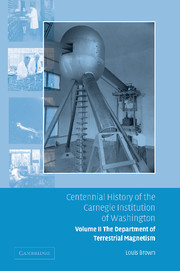Book contents
- Frontmatter
- Contents
- Foreword by Richard A. Meserve
- Preface
- 1 Establishment
- 2 Cruises and war
- 3 Expeditions
- 4 Measurements: magnetic and electric
- 5 The Fleming transition
- 6 The last cruise
- 7 The magnetic observatories and final land observations
- 8 The ionosphere
- 9 Collaboration and evaluation
- 10 The Tesla coil
- 11 The Van de Graaff accelerator
- 12 The nuclear force
- 13 Fission
- 14 Cosmic rays
- 15 The proximity fuze and the war effort
- 16 The Tuve transition
- 17 Postwar nuclear physics
- 18 The cyclotron
- 19 Biophysics
- 20 Explosion seismology
- 21 Isotope geology
- 22 Radio astronomy
- 23 Image tubes
- 24 Computers
- 25 Earthquake seismology
- 26 Strainmeters
- 27 The Bolton and Wetherill years
- 28 Astronomy
- 29 The solar system
- 30 Geochemistry
- 31 Island-arc volcanoes
- 32 Seismology revisited
- 33 Geochemistry and cosmochemistry
- 34 The Solomon transition
- 35 The support staff
- 36 Epilogue
- Notes
- Index
12 - The nuclear force
Published online by Cambridge University Press: 06 January 2010
- Frontmatter
- Contents
- Foreword by Richard A. Meserve
- Preface
- 1 Establishment
- 2 Cruises and war
- 3 Expeditions
- 4 Measurements: magnetic and electric
- 5 The Fleming transition
- 6 The last cruise
- 7 The magnetic observatories and final land observations
- 8 The ionosphere
- 9 Collaboration and evaluation
- 10 The Tesla coil
- 11 The Van de Graaff accelerator
- 12 The nuclear force
- 13 Fission
- 14 Cosmic rays
- 15 The proximity fuze and the war effort
- 16 The Tuve transition
- 17 Postwar nuclear physics
- 18 The cyclotron
- 19 Biophysics
- 20 Explosion seismology
- 21 Isotope geology
- 22 Radio astronomy
- 23 Image tubes
- 24 Computers
- 25 Earthquake seismology
- 26 Strainmeters
- 27 The Bolton and Wetherill years
- 28 Astronomy
- 29 The solar system
- 30 Geochemistry
- 31 Island-arc volcanoes
- 32 Seismology revisited
- 33 Geochemistry and cosmochemistry
- 34 The Solomon transition
- 35 The support staff
- 36 Epilogue
- Notes
- Index
Summary
The fundamental rule for theorists trying to unravel the intricate structures of nuclei is that the nuclear component of the force between two nucleons, be they two protons, two neutrons or a proton and neutron, is attractive and identical. This rule, the foundation of nuclear structure theory, came about in 1935 from experiments done by Tuve, Hafstad and Norman Heydenburg, who recently had joined the group. The first and most difficult of the experiments was the scattering of protons by protons. This had been in the minds of Breit and Tuve from their earliest days; it simply seemed to be the most fundamental experiment they could undertake. It was also just about the most difficult that they could have done at the time, an experiment that demanded the ultimate in precision accelerator techniques.
The experiment done by Rutherford in 1911 established the way in which many nuclear properties have been discovered. He collimated alpha particles from a radioactive source into a narrow beam that he passed through a very thin foil of gold. Nearly all of them continued through without significant deflection, but a very small fraction were scattered through large angles, some 180°. This result was explained by an astounding theory: that the overwhelming mass of the gold atom and all of its positive charge was concentrated in a tiny volume, the nucleus. In this experiment the force operating between target nucleus and projectile was the Coulomb electric force, following its inverse-square law down to sub-atomic dimensions.
- Type
- Chapter
- Information
- Publisher: Cambridge University PressPrint publication year: 2005



